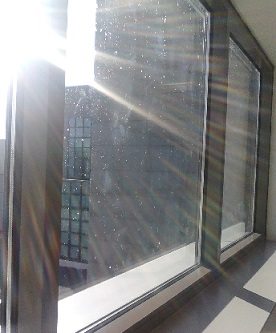WINDOW RESTORATION, GLASS CLEARING & REPAIR: Mineral Stains Removal
Not all glass windows can be restored when mineral staining and corrosion occurs, but GHB Window Cleaning Inc. has products available that will almost certainly remove the entire window mineral staining problem. However, if the glass is in Stage II corrosion, some of the panes may have to be replaced, but generally, our professional team of experts can save glass and restore windows.
Property owners have these 3 window restoration choices:
- Do nothing and replace all of the glass.
- “Clear” and “restore” all of the glass.
- “Clear” and possibly have to replace a few panes, specifically those panes that have progressed onto Stage II corrosion.
Both the 2nd and 3rd options are much less costly than the 1st, but GHB wants to give the decision to the owners and property managers. Remember that the glass is already beyond normal cleaning methods and that window restoration and window clearing is the solution. To prevent mineral staining and glass corrosion in the future a proper window cleaning maintenance program is strongly recommended and the only solution to protect windows.
Q. How does corrosion occur?
A. Corrosion occurs when the pH (degree of alkalinity with 7 as neutral) becomes too high (above 9). Hydrogen from water will mix with the sodium of soda lime glass to form sodium hydroxide, a strong alkali. Mineral deposits (lime, calcium, lead and salts), even detergent not thoroughly rinsed, will react with the chemical make-up of the glass causing corrosion. Acids are used to return the pH to neutral. There are two types of corrosion Stage I (light corrosion, little or no damage to glass) and Stage II (severe corrosion, damaged glass, etched glass).
Q. What is Stage II corrosion?
A. When the mineral deposits are no longer on the surface of the glass. The deposit has started to break down the molecular structure of the glass. This is evident when you remove the surface stain and etching or white hazing appears. This stage of window corrosion is also called glass “falling apart”.
Window Restoration – Professional Solutions:
Q. What type of products do you use to remove corrosion from glass?
A. We use a blend of acids and other specific proprietary ingredients that safely and effectively remove corrosion from glass.
Q. What is the product used for?
A. The product will remove hard water marks, exhaust from car and aircraft, run-off from unsealed masonry, airborne pollution, acid rain and just about anything that has caused corrosion of the glass. The product is specifically used as a glass clearing agent and is not to be used as a window cleaner. The service preformed is a window restoration service and should be treated as such.
Q. Will Window Restoration and glass clearing restore all glass problems?
A. No. The product cannot repair damaged glass – it can only help restore appearance. Alkaline runoff and Stage I corrosion haze can often be eliminated, but visible and invisible Stage II corrosion often cannot be eliminated. Remember that the glass is already damaged to the point that normal cleaning is ineffective. Replacement is may be necessary.
Q. When does a window need to be replaced or window restoration ineffective?
A. If the damage to the glass is severe or if the corrosion has reached Stage II, there may be little any product can do to restore clarity to the glass. Most glass manufacturers recommend replacement when Stage II is reached.
Q. What can be done about Stage II corrosion?
A. Options are limited, remember, the damage is already done. The building owner can replace the glass or you can use a rubbing compound that is time consuming and labor intensive. Both are expensive options.



